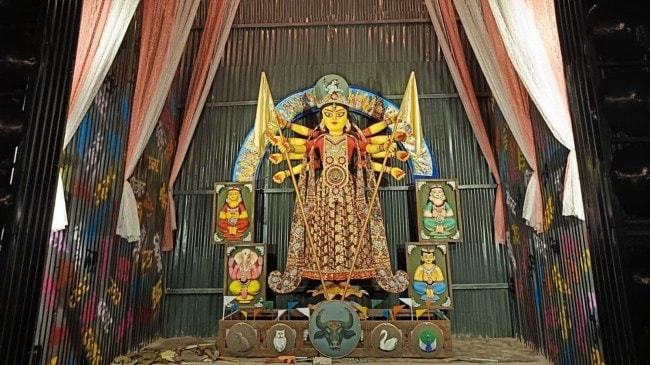Opinion Why Kolkata’s Durga pujo will always be home for the heart
Durga pujo is about belonging -- not only to the goddess, but to a city that remakes itself in joy. That belonging, once taken for granted, now feels fragile, frayed by distance and the cruel arithmetic of jobs
 Even if I cannot be there, Calcutta’s pujo has never left me
Even if I cannot be there, Calcutta’s pujo has never left me Durga Puja, for me, has been synonymous with sleepless nights and endless wanderings. Back home in Calcutta, pujo, as we Bengalis call it, arrives like a tidal wave of lights, crowds, and music, sweeping us into its rhythm. Afternoons blur into evenings, evenings into dawn, as we drift from one pandal to the next, eating egg rolls at improbable hours, sweating in the crush of strangers who somehow feel like family. The beat of the dhaak, the swirl of dhunuchi smoke, the thrill of slipping into notun jama — these traditions eventually became lifelines growing up. For a few days, the city belongs wholly to us, Maa Durga’s restless children, who roam its streets as if time has no claim on us.
This year it’s different. Nostalgia is cruel that way. It resurfaces precisely when I’m tied to my desk in Delhi, where Durga Pujo feels more like a cultural performance than a heartbeat. In Delhi, pujo is a neat, contained affair. The pandals are functional, sometimes impressive, but they lack the heart and art that Calcutta pours into every structure. They shut early, long before the night can swell into magic. Everything feels curated — sponsors’ banners hang prominently, branded food stalls line the entrances, and visitors drift in as though to a weekend fair. The spontaneity, the abandon, the sense of a city surrendering itself to the goddess — that, I believe, belongs to Calcutta alone. Delhi’s pujo feels like a replica; Calcutta’s is life itself.
Since moving away in 2017, I’ve made it home for a few pujos, but I have missed most. Journalism doesn’t run on holiday calendars. Every year is a lottery, whose turn it is to take leave, who must stay behind to man the desk. Some years I win; many more, I lose. I watch from the outside: Scrolling through friends’ pictures, watching videos of para functions, listening to familiar pandal announcements that now sound like echoes from another life. The distance gnaws more on these days than any other.
I remember one Ashtami night from a couple of years ago in Calcutta when my friends and I walked for hours and queued for many more to see the deity at a famous pujo in south Calcutta. Dawn was breaking, our feet blistered, but we stayed anyway, unwilling to let go of the moment even in our 30s. That madness, that surrender to pujo’s spell, I have never found in Delhi. Here, Metro ceases operations on time, the streets empty out. In most areas, it feels like any other evening.
For years, I tell myself that work is also worship. That this is the compromise of adulthood. But the truth is harder. Who truly wants to live away from home during pujo? Who leaves their beloved hometown behind willingly? If Bengal had enough to offer its young, would so many of us bargain for a few days’ leave just to revisit our youth again? It is a quiet grief many of us carry: That our state, once a hub of possibility, now leaves little choice but departure for survival. And so our festivals, our rituals, are lived at a distance.
This pujo, like others, I am doing what I can outwardly. I’ve started this year’s celebrations with Birendra Krishna Bhadra’s Mahalaya in my Delhi apartment I cannot call home. Perhaps, I will stop by a few pandals in CR Park if time allows. Inwardly, I’ll be walking Calcutta’s streets, carried forward by the crush of the crowd, dazzled by the light on the goddess’s face, surrounded by friends who know why these bustling nights matter.
Durga pujo is about belonging — not only to the goddess, but to a city that remakes itself in joy. That belonging, once taken for granted, now feels fragile, frayed by distance and the cruel arithmetic of jobs.
Even if I cannot be there, Calcutta’s pujo has never left me. It lingers like an unfinished song, heavy with longing — long nights of laughter, the smell of incense, the sound of dhaak reaching even Delhi’s quiet rooms where I sit and remember my hometown during this magical time.
stela.dey@indianexpress.com






